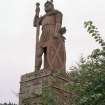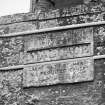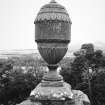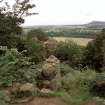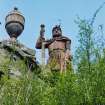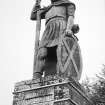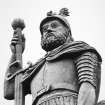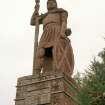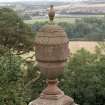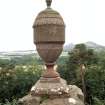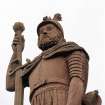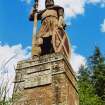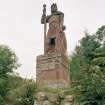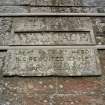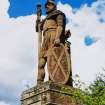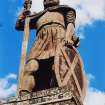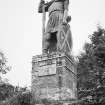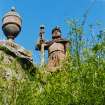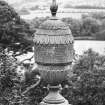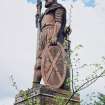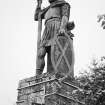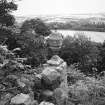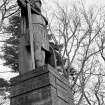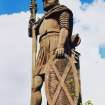Dryburgh, Wallace's Statue And Ornamental Urn
Commemorative Monument (19th Century), Statue (19th Century)
Site Name Dryburgh, Wallace's Statue And Ornamental Urn
Classification Commemorative Monument (19th Century), Statue (19th Century)
Alternative Name(s) Bemersyde House; Wallace Statue
Canmore ID 71817
Site Number NT53SE 103
NGR NT 59156 32697
Datum OSGB36 - NGR
Permalink http://canmore.org.uk/site/71817
- Council Scottish Borders, The
- Parish Mertoun
- Former Region Borders
- Former District Ettrick And Lauderdale
- Former County Berwickshire
NT53SE 103 59156 32697
For Bemersyde House see NT53SE 9.00
Notes:
The subject consists of a giant stone statue (some 31 feet high) of William Wallace and a classical funeral-style urn built on an outcrop above the River Tweed. It was built for David Stuart Erskine, Earl of Buchan, c.1814. The sculptor was John Smith. The urn is inscribed with the following lines:
Sacred to the memory of Wallace
The peerless Knight of Ellerslie [sic]
Who wav'd on Ayr's Romantic shore
The beamy torch of Liberty
And roaming round from Sea to Sea
From Glade obscure of gloomy Rock
His bold companions call'd to free
The Realm from Edward's Iron Yoke.
Information from RCAHMS
(NMC) March 2003.
Online Gallery (1306 - 1329)
The year 2014 sees the 700th anniversary of the Battle of Bannockburn, in which the army of Robert I of Scotland defeated that of Edward II of England. The battle marked a major turning point in the long, drawn-out struggle of the Wars of Independence.
The Wars have had a lasting influence upon all the nations of the United Kingdom and upon the national story. Each age has seen fit to commemorate the events in its own way: through the perpetuation of the genuine historical associations of buildings and places and also through the endowment of others with improbable or fanciful traditions. Where past generations allowed its historic buildings to decay and disappear, later generations began to value and actively preserve these for their associations. Where an event lacked a tangible reminder, as at Kinghorn where Alexander III was killed in a riding accident, a commemorative monument would be erected to act as a focus. The Wars of Independence predate the fashion for accurate portraiture: the weathered, generic military effigy of Sir James Douglas is one of the few to survive in Scotland. Later centuries saw a need and supplied it by a crowd of images of its historic heroes, William Wallace and Robert the Bruce, each depicted according to contemporary taste and imagination. The opening of the new heritage centre at Bannockburn takes this into a new dimension, through the use of three-dimensional, digital technology.
RCAHMS Collections hold many images of these buildings and locations from battlefields, castles and churches, to the many commemorative monuments erected in later years. This gallery highlights a selection of these, including antiquarian sketches, photographic and drawn surveys, and architectural designs.
Photographic Survey (March 1961)
Photographic survey by the Scottish National Buildings Record in March 1961.
Sbc Note (15 April 2016)
Visibility: Standing structure or monument.
Information from Scottish Borders Council
































